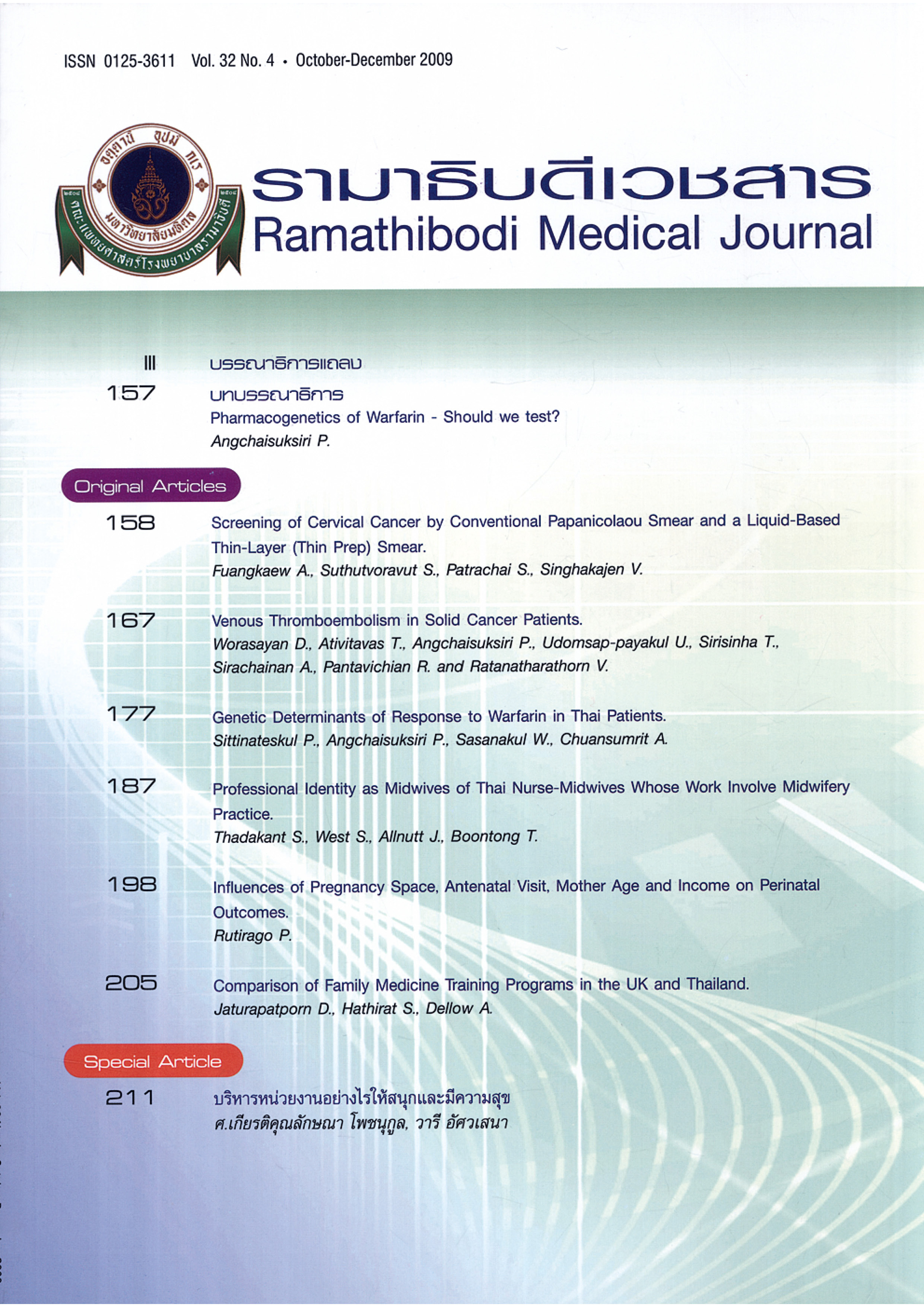Influences of Pregnancy Space, Antenatal Visit, Mother Age and Income on Perinatal Outcomes
Main Article Content
Abstract
Objectives: The objectives of this study were to determine the influences of pregnancy space, antenatal visit, mother age and income on unwanted outcomes like preterm birth and low birth weight to women who gave birth at Trang Hospital of Trang Province.
Method: The retrospective study of 475 singleton pregnancies who did deliver between July-December, 2009 at Trang Hospital were recruited in this study the medical records including pregnancy spacing, Antenatal visit, mother age and income were compared Associated factors with preterm birth and low birth weight were calculated using unadjusted odds ratios and Chi-square analysis
Results: The risk factors for preterm birth and low birth weight in this study were pregnancy spacing, antenatal visit, maternal age and income. Meanwhile, pregnancy space, antenatal visit, maternal age and income towards unwanted outcomes, pregnancy space gave the lowest risks. Low number of antenatal visits (<4) gave the highest risk for preterm birth (OR = 71.58 and 95%CI = 21.80-235.08) and low birth weight (OR = 29.82 and 95%CI = 16.05-55.43).
Conclusions: The low number of antenatal visits has the most significant affect on the risks of adverse outcomes. This work also implied that health-related services for low income family should be established to ensure a better health for both mother and child.
Article Details
References
Kelly MM. The basics of prematurity. J Pediatr Health Care. 2006;20(4):238-244. doi:10.1016/j.pedhc.2006.01.001.
McCormick MC, Behrman RE. The quiet epidemic of premature birth: commentary on a recent Institute of Medicine report. Ambul Pediatr. 2007;7(1):8-9. doi:10.1016/j.ambp.2006.10.002.
Centers for Disease Control and Prevention (CDC). From the Centers of Disease Control and Prevention. Use of assisted reproductive technology--United States, 1996 and 1998. MMWR Morb Mortal Wkly Rep. 2002;51(5):97-101.
Zhang J, Meikle S, Grainger DA, Trumble A. Multifetal pregnancy in older women and perinatal outcomes. Fertil Steril. 2002;78(3):562-568. doi:10.1016/s0015-0282(02)03272-7.
Gold R, Connell FA, Heagerty P, Bezruchka S, Davis R, Cawthon ML. Income inequality and pregnancy spacing. Soc Sci Med. 2004;59(6):1117-1126. doi:10.1016/j.socscimed.2004.01.004.
Conde-Agudelo A, Rosas-Bermúdez A, Kafury-Goeta AC. Birth spacing and risk of adverse perinatal outcomes: a meta-analysis. JAMA. 2006;295(15):1809-1823. doi:10.1001/jama.295.15.1809.
World Health Organization. Report of a WHO technical consultation on birth spacing. Geneva: Switzerland; 2005. Available from: https://www.academia.edu/219915/Report_of_a_WHO_technical_consultation_on_birth_spacing.
Zhu BP, Le T. Effect of interpregnancy interval on infant low birth weight: a retrospective cohort study using the Michigan Maternally Linked Birth Database. Matern Child Health J. 2003;7(3):169-178. doi:10.1023/a:1025184304391.
Zhu BP, Rolfs RT, Nangle BE, Horan JM. Effect of the interval between pregnancies on perinatal outcomes. N Engl J Med. 1999;340(8):589-594. doi:10.1056/NEJM199902253400801.
Conde-Agudelo A, Belizán JM. Maternal morbidity and mortality associated with interpregnancy interval: cross sectional study. BMJ. 2000;321(7271):1255-1259. doi:10.1136/bmj.321.7271.1255.
Fuentes-Afflick E, Hessol NA. Interpregnancy interval and the risk of premature infants. Obstet Gynecol. 2000;95(3):383-390. doi:10.1016/s0029-7844(99)00583-9.
Haram K, Mortensen JH, Wollen AL. Preterm delivery: an overview. Acta Obstet Gynecol Scand. 2003;82(8):687-704. doi:10.1034/j.1600-0412.2003.00218.x.
Khatun S, Rahman M. Socio-economic determinants of low birth weight in Bangladesh: a multivariate approach. Bangladesh Med Res Counc Bull. 2008;34(3):81-86. doi:10.3329/bmrcb.v34i3.1857.
Coria-soto IL, Bobadilla JL, Notzon F. The effectiveness of antenatal care in preventing intrauterine growth retardation and low birth weight due to preterm delivery. Int J Qual Health Care. 1996;8(1):13-20. doi:10.1093/intqhc/8.1.13.
Munjanja SP, Lindmark G, Nyström L. Randomised controlled trial of a reduced-visits programme of antenatal care in Harare, Zimbabwe. Lancet. 1996;348(9024):364-369. doi:10.1016/s0140-6736(96)01250-0.
Chirayus S. The Risk of poor antenatal care on low birth weight and preterm labor. Khon Kaen Med J. 2008:32:121-7.
Suvithayasiri V. The relationship of poor antenatal care and low birth weight and preterm labor. Vajira Med J. 2003:47:9-16.
World Health Organization. WHO publications (serial online). Available from: http://www.who.int/reproductivehealth/publications/RHR_01_30/.
Olsen SF, Secher NJ. Low consumption of seafood in early pregnancy as a risk factor for preterm delivery: prospective cohort study. BMJ. 2002;324(7335):447. doi:10.1136/bmj.324.7335.447.
Bendich A. Micronutrients in women's health and immune function. Nutrition. 2001;17(10):858-867. doi:10.1016/s0899-9007(01)00649-9.
Ramakrishnan U, Manjrekar R, Rivera J, Gonzales-Cossio T, Martorell R. Micronutrients and pregnancy outcome: a review of the literature. Nutr Res. 1999:19(1):103-159.
Ross DP, Roberts P. Income and Child Well-being: A New Perspective on the Poverty Debate. Ottawa: Canadian Council on Social Development; 1999:2:58-61.
Gwin K, Schrader R, Peters K, Moreno A, Leslie K. Predictors of preterm birth in new Mexico: outcomes from 377,770 pregnancies over fifteen years, 2009. https://digitalrepository.unm.edu/ume-research-papers/62.
